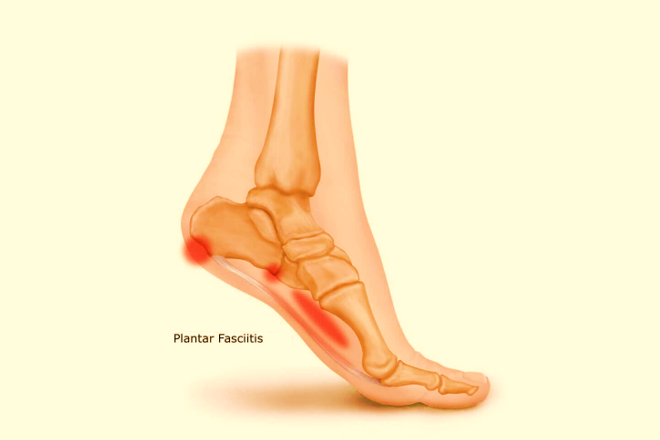One of the most common reasons behind heel pain is plantar fasciitis. The thick tissue that is under a human’s foot connects the bone of the heel till the toes get inflamed.
When a human being takes the first in the morning a stabbing pain is felt at the heel which is caused by plantar fasciitis. Gradually when a human being gets up and starts moving the pain slowly gets reduced.
However, it may return if the person keeps standing for a long period of time or if they stand up after sitting for a long time. This disease is most common among the people who are runners. Additionally, people who wear shoes that give inadequate support and are overweight tend to have plantar fasciitis. However, there aren’t several ways of treating plantar fasciitis. The doctors have come across an invention which is available in the stores and is known as plantar fasciitis insoles.
The Causes behind Plantar Fasciitis
The Plantar fascia of a human being is shaped like a bowstring that supports the arch of the foot which absorbs the shock that is caused due to the movement while walking. The fascia may get small tears if stress and tension occur on this bowstring greatly. However, the fascia may get inflamed if stretching and tearing keep occurring repeatedly. There is the risk of plantar fasciitis if:
- Females have a greater risk of getting plantar fasciitis, mostly the ones who are forty to sixty years old.
- In addition, people who are obese have a greater chance of having this disease.
- The ones with high arches or feet that are flat
- A person has an unusual position of the foot and walking.
- Wears shoes which have high heels.
- They are standing for a long time of the day.
- A person wears shoes that are worn out or have thin soles.
- A person who walks or keeps standing for a long time.
- Another reason behind causing plantar fasciitis can be ankylosing spondylitis or arthritis.
- Tight Achilles tendons, which are the tendons that attach the calf muscles of the heels, might also result in the pain that is caused due to plantar fascia.
Typically, plantar fasciitis is not the result of heel stimulation. It was believed by the doctors that the stimulation of the heel causes pain in people who are suffering from plantar fasciitis, but this is not the case.
Symptoms of plantar fasciitis
The bottom of the foot of a human being will feel tenderness and pain if they are suffering from plantar fasciitis. Generally, the tenderness is felt towards the heel. However, it may affect the entire sole of the foot.
A person who is suffering from plantar fasciitis may face difficulty while walking or running. In the morning the foot can particularly become sensitive and stiff, also while getting out of a car. It is very difficult for a human being who is suffering from plantar fasciitis to walk on hard surfaces being barefoot. On that account, at times the foot’s bottom portion can feel tenderness, warmth, and be swollen. It has been described by several people that the pain feels like an ache or bruise and while a person starts walking the pain gradually tends to go away.
However, if the walking is continued the pain returns again which only goes away if the foot is resting. After the drawn-out activity, due to increased inflammation or irritation, the pain can flicker up. Usually, people with plantar fasciitis do not feel pain while they are doing an activity, however, the pain is felt by them while they stop.
Diagnosis and Testing of Plantar fasciitis
A physical exam will be performed by the doctor in order to check if the foot is tender and to determine the exact location from where the pain is occurring. This is done in order to make sure that the pain is not occurring due to a different foot problem.
During the evaluation, the doctor may ask the patient to flex the foot while they press on the plantar fascia in order to see if the pain gets inferior as the person flexes and better points the toe. It will also be noted if the patient has mild swelling or redness. The doctor will calculate the strength of the muscles and the health of the nerves by checking the:
- balance
- muscle tone
- sense of sight and touch
- reflexes
- coordination
In order to check if anything else like a fracture of the bone is causing the pain in the foot, an MRI scan or X-ray might be required. The initial ways to treat plantar fasciitis are home remedies or treatments such as icing, using braces, rest, and using anti-inflammatory drugs. However, if the home remedies do not reduce the pain, the damaged section of the ligament is injected with a corticosteroid which might be helpful. The finest place for the injection can be determined by the doctor with the use of an ultrasound machine. Corticosteroids can also be applied by the doctors to the skin of the arch or the heel of the foot, and then a painless electrical current is applied so that the steroid can pass through the skin and then into the muscle.
Moreover, slipping plantar fasciitis insoles on the pairs of a comfortable shoe can be very helpful for arch pain and ease the heels. Moreover, a cushy cup is provided by plantar fasciitis insoles and it can be helpful in order to relieve pressure.
Conclusion
The treatment’s key part is physical therapy for plantar fasciitis. It may help to stretch the Achilles tendons and plantar fascia. In order to strengthen your lower leg muscles, a physical therapist can show exercises that may be helpful to stabilize the walk and reduce the workload on the plantar fascia. On the other hand, using plantar fasciitis insoles in the shoes can be helpful. If other methods are not working and the pain goes on, the doctor might suggest the therapy of an extracorporeal shock wave. The heels are bombarded with sound waves in this therapy so that the ligament can be stimulated for healing. As the treatment’s side effects, the followings can include:
- Bruises
- Pain
- Numbness
- Swelling
However, the therapy of extracorporeal shock wave has not been confirmed to be constantly successful in easing symptoms. Additionally, there are several types of plantar fasciitis insoles that the doctors suggest to the patient in order to cure the disease. If home remedies and medical treatments do not take care of the plantar fasciitis, the subsequent option is to think about surgery.














+ There are no comments
Add yours